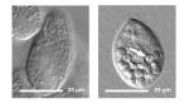(Press-News.org) Hydrologists may have a new way to study historical water conditions. By synthesizing present-day data with historical records they may be able to recreate broad hydrologic trends on a regional basis for periods from which scant data is available.
Lack of reliable historical data can impede hydrologists' understanding of the current state of waterways and their ability to make predictions about the future. That was the case for the rivers of the northeastern United States between 1600 and 1800, a period that runs from just before the first European settlers arrived to the onset of the Industrial Age.
"The historic perspective is important because humans have developed a particular approach to water that may not be sustainable," says Dr. Charles Vörösmarty, presidential professor of civil engineering in The Grove School of Engineering at The City College of New York. "(People) often impact a system and then spend lots of money to fix it. By studying how systems evolved, we may be able to look at success stories of the past and avoid problems emerging today and in other parts of the world."
Professor Vörösmarty was principal investigator for the study, which was produced by an interdisciplinary team of researchers from 15 institutions. It was one of just two funded under the National Science Foundation's Continental Hydrological Processes Program, and is a major component of a multi century-scale study of waterways in an area stretching from Maine to Chesapeake Bay.
"The reconstruction makes it possible to discern broad hydrologic trends," said Christopher L. Pastore, a University of New Hampshire historian and corresponding author for the report, which was published this month in "Environmental Science & Technology." "We're laying the groundwork for understanding the big picture: how Americans interacted with and changed their water resources over the broad sweep of time."
Graduate students attending a summer institute at Massachusetts Institute of Technology developed the conceptual model and recommendations. They identified four principal drivers of hydrological change: water engineering, land-cover change, climate change and human decision-making. The latter was overarching because it affects the other three. The model identified a baseline environment for the year 1600 and then worked forward.
Europeans' impact on the waterways was felt soon after they arrived, Professor Vörösmarty noted. For example, demand for beaver pelts reduced their population, and the dams the beavers had built collapsed because they were no longer being maintained. The signature of these changes was mapped on a regional scale and found to be substantial.
To develop their methodological model, the team first projected known data sets into a geographic information system and conducted simulations using hydrological models that were calibrated to modern data sets. Further corroboration was achieved, for example, by using British census records and local histories.
From these, they could estimate deforestation patterns and local hydrology change. Where possible, they scaled up these hydrological "snapshots" to make assertions across a larger area.
To apply the model, the team divided the region into three historically consistent sub-regions – New England, the mid-Atlantic colonies and the Chesapeake Bay area – and studied the effects of physical variables such as soil and climate and sociopolitical factors.
These human factors had significant impact on hydrological development. While the close-knit, religious communities of New England concentrated on fur trading and timber extraction, Chesapeake region saw widespread tree clearance and tobacco planting.
In addition to showing how the results of studies based on contemporary data sets can be corroborated with the accounts of environmental historians to reconstruct colonial-era hydrology, the work "underscores the importance of forging scholarly ties between the sciences and humanities."
"This opens the disciplines to new ways of thinking," Professor Vörösmarty said. "Geoscientists may be keyed into numerical data, use of maps and other quantitative data while historians take narratives and look at other information to construct a picture.
INFORMATION:
"We can assemble a picture that starts with information sets and they can corroborate what the data show. The historical scholarship community can take their studies to the next level by adapting quantitative information so the specifics they find through documenting local-scale histories can be reconfigured into broader generalizations."
CCNY-led interdisciplinary team recreates colonial hydrology
Work demonstrates benefits of scholarly ties between the humanities and the sciences
2010-12-21
ELSE PRESS RELEASES FROM THIS DATE:
What makes a face look alive? Study says it's in the eyes
2010-12-21
The face of a doll is clearly not human; the face of a human clearly is. Telling the difference allows us to pay attention to faces that belong to living things, which are capable of interacting with us. But where is the line at which a face appears to be alive? A new study published in Psychological Science, a journal of the Association for Psychological Science, finds that a face has to be quite similar to a human face in order to appear alive, and that the cues are mainly in the eyes.
Several movies have tried and failed to generate lifelike animations of humans. ...
Globalization burdens future generations with biological invasions
2010-12-21
A new study on biological invasions based on extensive data of alien species from 10 taxonomic groups and 28 European countries has shown that patterns of established alien species richness are more related to historical levels of socio-economic drivers than to contemporary ones. An international group of 16 researchers reported the new finding this week in the Proceedings of the National Academy of Sciences of the United States of America (PNAS). The publication resulted from the three-year project DAISIE (Delivering Alien Invasive Inventory for Europe, www.europe-aliens.org), ...
New report finds Cambodia's HIV/AIDS fight at critical crossroads in funding, prevention
2010-12-21
Phnom Penh, Cambodia (21 December, 2010) – Despite Cambodia's remarkable history in driving down HIV infections, a report released today on the future of AIDS in the country argues that future success is not guaranteed and the government needs to focus increasingly on wise prevention tactics and assume more of the financing of its AIDS program.
The report, called The Long-Run Costs and Financing of HIV/AIDS in Cambodia, written by Cambodian experts working closely with staff of the Results for Development Institute (R4D), based in Washington, D.C., finds that Cambodia, ...
How often do giant black holes become hyperactive?
2010-12-21
A new study from NASA's Chandra X-ray Observatory tells scientists how often the biggest black holes have been active over the last few billion years. This discovery clarifies how supermassive black holes grow and could have implications for how the giant black hole at the center of the Milky Way will behave in the future.
Most galaxies, including our own, are thought to contain supermassive black holes at their centers, with masses ranging from millions to billions of times the mass of the Sun. For reasons not entirely understood, astronomers have found that these ...
New study upends thinking about how liver disease develops
2010-12-21
In the latest of a series of related papers, researchers at the University of California, San Diego School of Medicine, with colleagues in Austria and elsewhere, present a new and more definitive explanation of how fibrotic cells form, multiply and eventually destroy the human liver, resulting in cirrhosis. In doing so, the findings upend the standing of a long-presumed marker for multiple fibrotic diseases and reveal the existence of a previously unknown kind of inflammatory white blood cell.
The results are published in this week's early online edition of the Proceedings ...
UCSB scientists demonstrate biomagnification of nanomaterials in simple food chain
2010-12-21
(Santa Barbara, Calif.) –– An interdisciplinary team of researchers at UC Santa Barbara has produced a groundbreaking study of how nanoparticles are able to biomagnify in a simple microbial food chain.
"This was a simple scientific curiosity," said Patricia Holden, professor in UCSB's Bren School of Environmental Science & Management and the corresponding author of the study, published in an early online edition of the journal Nature Nanotechnology. "But it is also of great importance to this new field of looking at the interface of nanotechnology and the environment."
Holden's ...
New imaging advance illuminates immune response in breathing lung
2010-12-21
Fast-moving objects create blurry images in photography, and the same challenge exists when scientists observe cellular interactions within tissues constantly in motion, such as the breathing lung. In a recent UCSF-led study in mice, researchers developed a method to stabilize living lung tissue for imaging without disrupting the normal function of the organ. The method allowed the team to observe, for the first time, both the live interaction of living cells in the context of their environment and the unfolding of events in the immune response to lung injury.
The finding ...
Strange new twist: Berkeley researchers discover Möbius symmetry in metamaterials
2010-12-21
Möbius symmetry, the topological phenomenon that yields a
half-twisted strip with two surfaces but only one side, has been a source of fascination since its discovery in 1858 by German mathematician August Möbius. As artist M.C. Escher so vividly demonstrated in his "parade of ants," it is possible to traverse the "inside" and "outside" surfaces of a Möbius strip without crossing over an edge. For years, scientists have been searching for an example of Möbius symmetry in natural materials without any success. Now a team of scientists has discovered Möbius symmetry in ...
New study examines immunity in emerging species of a major mosquito carrer of malaria
2010-12-21
In notable back-to-back papers appearing in the prestigioous journal Science in October, teams of researchers, one led by Nora Besansky, a professor of biological sciences and a member of the Eck Institute for Global Health at the University of Notre Dame, provided evidence that Anopheles gambiae, which is one of the major mosquito carriers of the malaria parasite in Sub-Saharan Africa, is evolving into two separate species with different traits.
Another significant study appearing in this week's edition of the Proceedings of the National Academy of Sciences (PNAS) and ...
New study focuses on nitrogen in waterways as cause of nitrous oxide in the atmosphere
2010-12-21
Jake Beaulieu, a postdoctoral researcher the Environmental Protection Agency in Cincinnati, Ohio, who earned his doctorate at the University of Notre Dame, and Jennifer Tank, Galla Professor of Biological Sciences at the University, are lead authors of new paper demonstrating that streams and rivers receiving nitrogen inputs from urban and agricultural land uses are a significant source of nitrous oxide to the atmosphere.
Nitrous oxide is a potent greenhouse gas that contributes to climate change and the loss of the protective ozone layer. Nitrogen loading to river networks ...
LAST 30 PRESS RELEASES:
Decoupling the HOR enhancement on PtRu: Dynamically matching interfacial water to reaction coordinates
Sulfur isn’t poisonous when it synergistically acts with phosphine in olefins hydroformylation
URI researchers uncover molecular mechanisms behind speciation in corals
Chitin based carbon aerogel offers a cleaner way to store thermal energy
Tracing hidden sources of nitrate pollution in rapidly changing rural urban landscapes
Viruses on plastic pollution may quietly accelerate the spread of antibiotic resistance
Three UH Rainbow Babies & Children’s faculty elected to prestigious American Pediatric Society
Tunnel resilience models unveiled to aid post-earthquake recovery
Satellite communication systems: the future of 5G/6G connectivity
Space computing power networks: a new frontier for satellite technologies
Experiments advance potential of protein that makes hydrogen sulfide as a therapeutic target for Alzheimer’s disease
Examining private equity’s role in fertility care
Current Molecular Pharmacology achieves a landmark: real-time CiteScore advances to 7.2
Skeletal muscle epigenetic clocks developed using postmortem tissue from an Asian population
Estimating unemployment rates with social media data
Climate policies can backfire by eroding “green” values, study finds
Too much screen time too soon? A*STAR study links infant screen exposure to brain changes and teen anxiety
Global psychiatry mourns Professor Dan Stein, visionary who transformed mental health science across Africa and beyond
KIST develops eco-friendly palladium recovery technology to safeguard resource security
Statins significantly reduce mortality risk for adults with diabetes, regardless of cardiovascular risk
Brain immune cells may drive more damage in females than males with Alzheimer’s
Evidence-based recommendations empower clinicians to manage epilepsy in pregnancy
Fungus turns bark beetles’ defenses against them
There are new antivirals being tested for herpesviruses. Scientists now know how they work
CDI scientist, colleagues author review of global burden of fungus Candida auris
How does stroke influence speech comprehension?
B cells transiently unlock their plasticity, risking lymphoma development
Advanced AI dodel predicts spoken language outcomes in deaf children after cochlear implants
Multimodal imaging-based cerebral blood flow prediction model development in simulated microgravity
Accelerated streaming subgraph matching framework is faster, more robust, and scalable
[Press-News.org] CCNY-led interdisciplinary team recreates colonial hydrologyWork demonstrates benefits of scholarly ties between the humanities and the sciences




